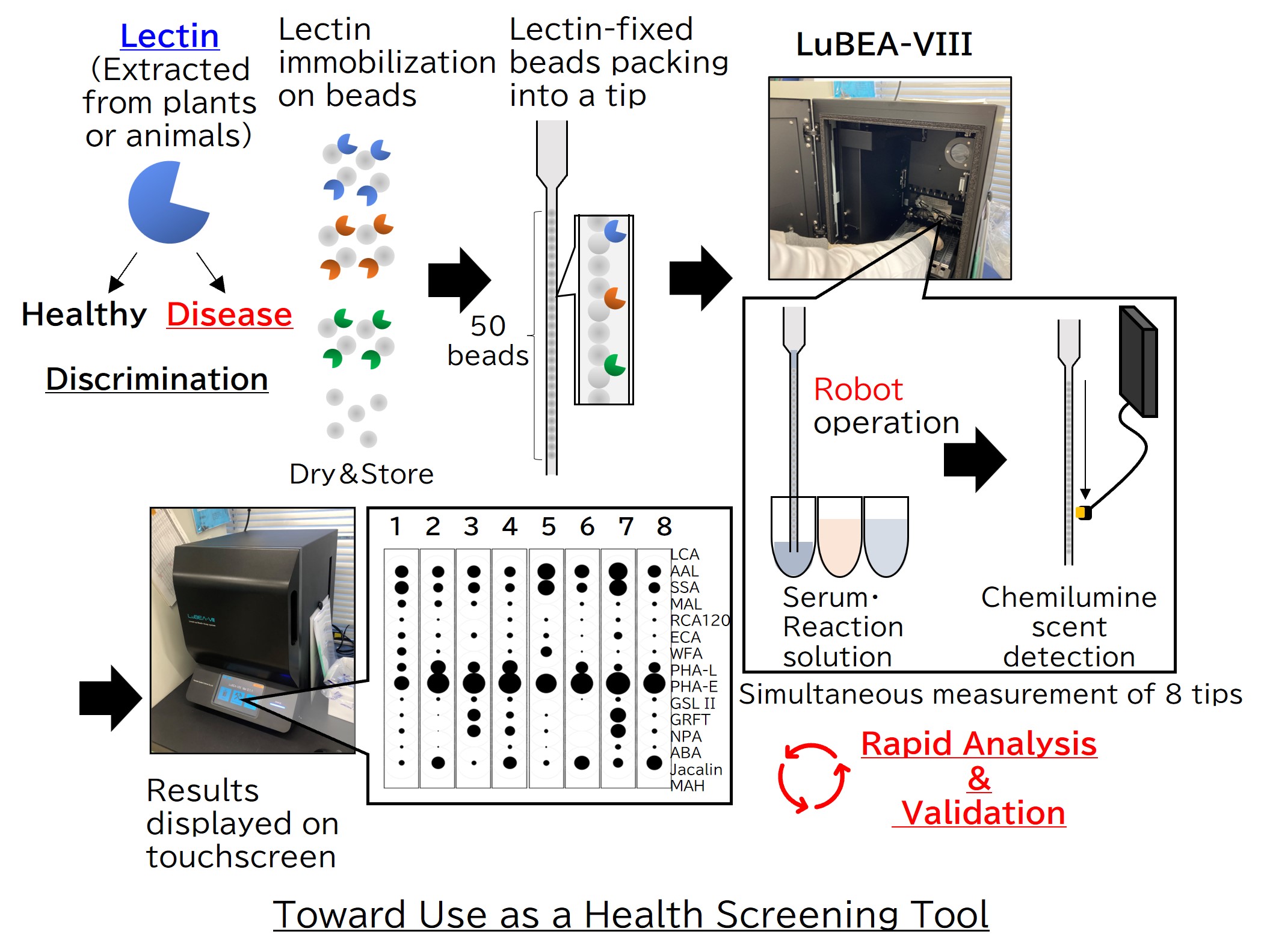Marking 20 Years of Glycan Profiling: From Innovation to Automation
TAIST marks the 20th anniversary of the first publication on its glycan profiling technology, the lectin microarray, which utilizes glycan-binding proteins known as lectins (1). To achieve this technology into a more versatile and automated system, Dr. Atsushi Kuno, Group Leader of the Molecular and Cellular Glycoproteomics Research Group, turned his attention to Beads array In Single Tip (BIST), a multiplexed detection platform developed by Precision System Science Co., Ltd. (PSS), and successfully validated its applicability for glycan profiling (2,3). Working closely with Dr. Sayaka Fuseya and other researchers, the team continued development and implementation efforts (4), culminating in the launch of a fully automated BIST device capable of processing eight samples simultaneously, now commercially available as LuBEA-VIII from PSS (5,6).
The concept of glycan profiling was originally proposed in 2003 by Prof. Jun Hirabayashi (former Team Leader at Research Center for Glycoscience, AIST). His vision was to create an approach accessible even to beginners—such as students and industrial researchers—for routine glycan analysis. This new system realizes that vision: from sample setup to data acquisition, all steps are automated with minimal user intervention. The LuBEA-VIII system offers a robust technological foundation for standardized, high-throughput glycomics and is expected to find broad application in fields such drug discovery, diagnostics, and basic research (7).
LuBEA-VIII enables fully automated glycan profiling. Once protein samples and lectin beads tips are loaded into the LuBEA-VIII device, robotic operation performs all binding reactions and data acquisition automatically. Glycan presence and structural features are quantified within 1 hour.

Collaboration
Precision System Science Co., Ltd.
References
1
Title:Evanescent-field fluorescence-assisted lectin microarray: a new strategy for glycan profiling.
Authors:Shimazaki H, Saito K, Matsuda A, Sawakami K, Kariya M, Segawa O, Miyashita Y, Ueda T, Koizuka M, Nakamura K, Kaji H, Tajima H, Kuno A.
Journal:Nat Methods, 2005, 2(11), 851-6
DOI:10.1038/nmeth803
2
Title:Lectin Bead Array in a Single Tip Facilitates Fully Automatic Glycoprotein Profiling.
Authors:Kuno A, Uchiyama N, Koseki-Kuno S, Ebe Y, Takashima S, Yamada M, Hirabayashi J.
Journal:Anal Chem 2019, 91(17), 11162-11169
3
Title:Auto-Lectin Dotcoding by Two Octopuses: Rapid Analysis of Fluorescence-Labeled Glycoproteins by an 8‑channel Fully-Automatic Bead Array Scanner with a Rolling-Circle Detector.
Authors:Shimazaki H, Nakamura K, Ono A, Segawa O, Sawakami K, Koizuka M, Hirayama M, Hori K, Tajima H, Kuno A.
Journal:Anal Chem 2023, 95(32), 11868-11873
4
Title:Rapid Glyco-Qualitative Assessment of Recombinant Proteins Using a Fully Automated System.
Authors:Fuseya S, Ono A, Ootani H, Mizukado S, Obayashi T, Tanaka N, Shimazaki H, Kajiyama K, Ashitomi M, Yasuda S, Miyabe T, Nakamura K, Segawa O, Sawakami K, Kuno A.
Journal:Journal of Visualized Experiments 2024, 208
DOI:10.3791/66571
5
Press release:Launch of “LuBEA-VIII” glycan profiling system
6
7
Title:M2BPgs-HCC: An Automated Multilectin Bead Array Indicating Aberrant Glycosylation Signatures Toward Hepatitis C Virus-Associated Hepatocellular Carcinoma Prognosis.
Authors:Shimazaki H, Uojima H, Yamasaki K, Obayashi T, Fuseya S, Sato T, Mizokami M, Kuno A.
Journal:Molecules 2024, 29(23), 5640,
Acknowledgments
This achievement was made possible with the support of the 2016 AMED Glycosylation Drug Discovery Project and the 2020 JST A-STEP Industry-Academia Collaboration [stage II] “JPMJTR204A.”